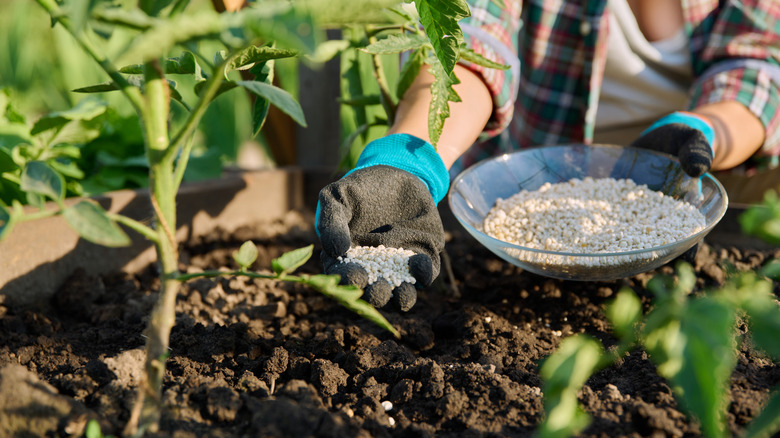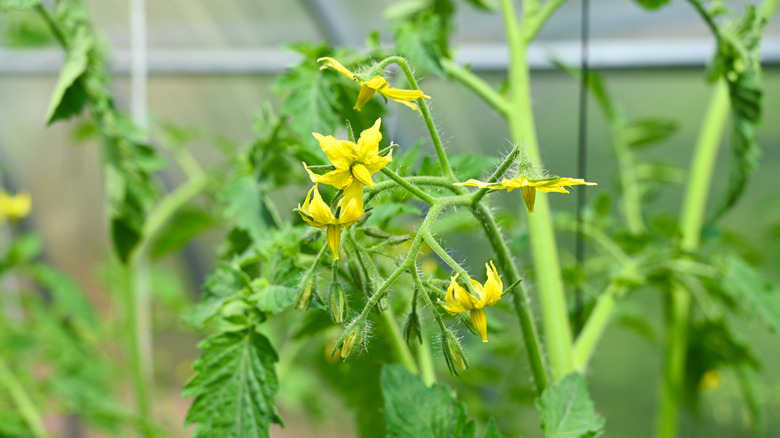How To Help Your Tomato Plants Flourish When They've Started Flowering
Having extremely green and lush leaves doesn't necessarily mean that your plants are thriving. That's especially the case when seemingly strong, healthy tomato plants aren't producing enough flower buds. This mysterious situation can stem from improper care, such as overfeeding your plants with nitrogen. You might have heard that tomatoes are heavy feeders and thought that they require more nitrogen than other plants, but that's a common misconception. Tomatoes require a wide variety of nutrients to stay healthy during their various growth stages. During the flowering stage, the most important thing to do is to balance your plants' nitrogen, phosphorus, and potassium intake. Your flowering tomato plants will flourish if you use a fertilizer that's lower in nitrogen and has a higher dose of phosphorus and potassium.
Knowing exactly how to fertilize your tomato plants depending on their growth stage will save you a lot of time and effort. Indeed, tomatoes require nitrogen, as it is a primary component in the creation of many vitamins and enzymes that form the green parts of the plant. It's also an essential nutrient during early growth. Nevertheless, when the plant starts flowering, having excess nitrogen in the soil will divert the plant's energy from flower formation to the production of leafy greens. This, in turn, will delay the reproductive cycle of the plant, resulting in a plant that looks extremely healthy, but can't set its flower buds.
How to fertilize tomato plants during flowering season
When tomato plants start to flower, their root system needs to be able to provide sufficient support, water, and nutrients, and their stems also need to be sturdy enough to support the growth of flowers and, later on, fruits. This is why adding phosphorus to the soil is crucial during the flowering season. This nutrient stimulates root development and strengthens the plant's stalks and stems. It also increases flower production. A pro tip is to let your plants form strong stems first, before they start flowering. If you see that your tomato plants still have light green, thin stems, it's best to pinch off early flower buds and give them more time to grow bulkier stems.
Another essential nutrient during this stage is potassium, as it aids in water movement, sugar production, and fruit development. Fertilizing with potassium will give you better quality tomatoes and a bigger harvest, as well as making your tomatoes sweeter and more acidic. However, before you buy any fertilizer, you need to get your soil tested. Different soils have different nutrient levels and pH values. If your soil's pH lies within the optimal range for tomatoes, 6.2 to 6.8, and you don't have any specific deficiencies in your soil, you can use a complete NPK commercial fertilizer with either 10-20-10, 5-10-10, or a similar nutrient ratio when the plant starts flowering. What's important here is to keep your phosphorus (P) and potassium (K) higher than your nitrogen (N) to support flower production. Avoid using ammonia-based fertilizers like urea or ammonium nitrate, as they can cause calcium deficiency and inhibit growth.
Other ways to support flowering tomatoes
Aside from offering tomato plants the right amount of nitrogen, phosphorus, and potassium, it's also important to account for environmental conditions, sufficient watering, and avoiding calcium deficiency. Depending on your plant's variety, some tomato flowers grow best with night temperatures above 55 degrees Fahrenheit. If you experience colder nights, you can use blossom set sprays to prevent flower drop. Flowering tomatoes also prefer daytime temperatures that peak at 85 degrees to allow for pollen to travel freely without becoming sticky. Extended high temperatures can stress your plants and prevent flower development. During heatwaves, mulching, especially with straw, clean hay, or paper, can help regulate soil temperature and retain moisture.
Additionally, tomatoes need regular watering — about 1 to 2 inches of water every week. Less water will reduce flower production. It can also lead to a calcium deficiency, which can become a serious problem during fruit development, causing blossom end rot. That's because the plant needs enough water to dissolve and carry the calcium through its system. What's concerning here is that your soil test might show a good amount of calcium, but because of inadequate watering, your plants may still experience a calcium deficiency and blossom end rot. What's more, low calcium levels can also reduce the efficiency of your fertilizers. Other than consistent and deep waterings, you can also counter this problem by using organic slow-release fertilizers like fish bone meal or crushed eggshells.


